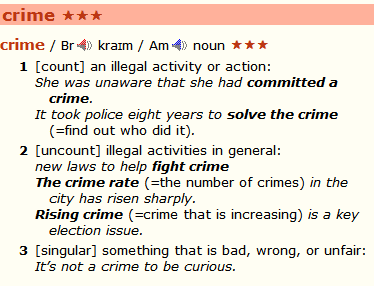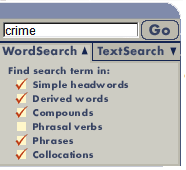|

FROM THE EDITOR
 In
this Issue In
this Issue
 Contributors Contributors
 Letters
to the Editor Letters
to the Editor
 Write
to Us Write
to Us
 Spread
the Word Spread
the Word
 Back
Issues Back
Issues
FEATURE
 What's
in a word? What's
in a word?
Professor Michael Hoey
considers the consequences
of changes in lexicography
COLUMNS
 Language
Interference Language
Interference
False Friends between
Spanish and English
Read about cognates, false friends
and unreliable friends
 Focus
on Language Focus
on Language
Awareness: Word formation
Introduction
Common processes of
word formation in English
UK
version ¦ US
version
 New
word of the month New
word of the month
Compounds and blends
 Top
Tips for the CD-ROMs Top
Tips for the CD-ROMs
Using the CD-ROM for
teaching collocations
 onestopenglish.com onestopenglish.com
|
 |
Top
Tips for the CD-ROMs
by Mairi
MacDonald
1 Collocation
boxes
Like the paper dictionary, the CD-ROMs give additional
information about collocation at the entry of the relevant word. Unlike
the paper dictionary, the CD-ROMs allow you to jump straight to any entry
that has this information.
|
|
|
| • |
Select SmartSearch |
• |
Select SmartSearch |
| • |
Check Vocabulary notes |
• |
Check More search options |
| • |
Check Collocations |
• |
Check Editorial notes |
| • |
Click on Go |
• |
Check Collocations |
|
|
• |
Click on Go |
The search results panel on the bottom left of the screen
will display 130 entries in the Essential CD and 447 in MED
CD. Click on any of these results to go to that entry. The collocation
box will be on the right.
|
Activity
1 Guess the word
| Aim: |
To introduce/revise the concept of collocation |
| Level: |
Upper intermediate to advanced |
| 1 |
Select 5-10 entries which have collocation
boxes using the search results from above. |
| 2 |
Copy the collocates from the panel on the right. |
| 3 |
Read out the words to the class who have to
guess what the original word is. This can be played as a team
game. |
| 4 |
Students can then complete the worksheet
as consolidation. |
|
2 Other ways of finding collocations
and patterns
a At the entry of the word
What do you do if there is no collocations box for a word
you want your students to concentrate on? The following entry for crime
is from the Essential CD-ROM. Collocations (e.g. commit/solve
a crime, fight crime, crime rate, rising crime) are
clearly marked in bold in the dictionary.

b Using WordSearch
You can also widen your search using WordSearch.
Type in crime in the search box. Expand the search panel by clicking
on WordSearch. Select Phrases and Collocations and
click on Go.

This will give you 11 results in the Essential
(26 in MED): crime, crime wave, organized crime,
war crime, committed a crime, solve the crime, fight
crime, the crime rate, rising crime, crime doesn't
pay and violent crime. Click on each of these to find the following
examples:
She was unaware that she had committed
a crime.
It took police eight years to solve the crime.
new laws to help fight crime
The crime rate in the city has risen sharply.
Rising crime is a key election issue.
a fall in violent crime
The message is simple: crime doesn't pay.
c Using TextSearch
TextSearch can produce a list of examples to allow
students to look at the word in context. Type crime into the search
panel. Expand the TextSearch button by clicking on it. Check the
Examples option and then click on Go. Click on each result
to view an example. Click
here for selection of examples copied from the Essential CD.
|
Activity
2 Exploring collocations
| Aim: |
To get students to think about how a specific
word (e.g. crime) is used. |
| Level: |
Upper intermediate to advanced |
| 1 |
Show students the following examples from
the main entry for crime and ask them the difference
between the following columns:
|
Column
1
new laws to help fight
crime
The crime rate in the city has risen sharply.
Rising crime is a key election issue.
|
Column
2
She was unaware
that she had committed a crime.
It took police eight
years to solve the crime.
|
|
| 2 |
Elicit that Column 1 shows examples of crime
as an uncountable noun and Column 2 shows examples of crime
as a countable noun. |
| 3 |
Get students to use TextSearch to find
examples for crime (see above). |
| 4 |
As they find the examples, students paste
them into a table
according to whether the example is countable or uncountable.
It doesn't matter that some of the patterns and collocates
are repeated as this will reinforce how the word is used.
|
|
Tip
You
might want to give a pre-prepared list of examples depending
on the level of your students.
|
|
| 5 |
Next get the students to subdivide the examples
into the following categories and add them in the correct
part of this
table:
verbs associated with crime
adjectives
associated with crime
nouns
associated with crime
|
| 6 |
Students should highlight the relevant word
or phrase in a different colour. |
| 7 |
Once this is complete you can use the table
as a basis for discussing similarities and differences between
collocates of crime as a countable noun and uncountable
noun, any patterns that emerge and word order issues. |
|
|
Tip
Use TextSearch
in the same way to find example sentences for other words. Students
can try and identify grammar patterns as well as collocation in
the examples you extract from the dictionary e.g.:
Type cause* into
the search box to find example sentences containing cause,
causes, caused etc.
Do the collocates have a mostly positive or negative meaning?
|
|





